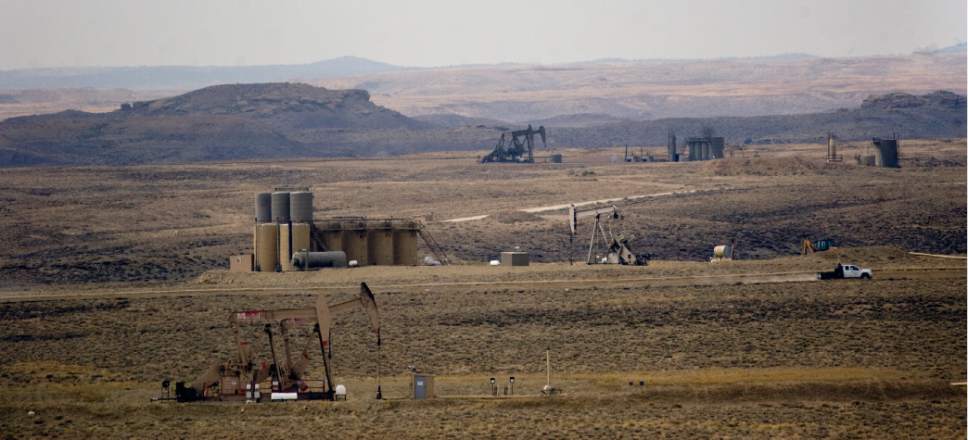This is an archived article that was published on sltrib.com in 2016, and information in the article may be outdated. It is provided only for personal research purposes and may not be reprinted.
A federal judge this week invalidated the Bureau of Land Management's approval of a drilling program in the Uinta Basin, saying its underlying environmental analysis was insufficient, given the thousands of wells expected to be drilled in the region that can be expected to contribute to the rural region's worsening air quality.
The BLM failed to consider this when it approved the 16-well gas project proposed by Gasco Energy, ruled U.S. Magistrate Evelyn Furse. In her 30-page ruling, released Monday, Furse said the National Environmental Policy Act requires federal land managers to "accurately account for the environmental impact of all reasonably foreseeable actions, not merely the incremental impact" of the project under analysis.
Without examining "cumulative" ozone pollution arising from the basin's oil and gas activity, the BLM's finding of no significant impact was poorly founded, especially when the agency, without offering an explanation, relied on a document that gave questionably low estimates of future drilling.
"The court was clear that BLM cannot view the environmental impacts of drilling these 16 wells in isolation. Rather, it needs to consider those impacts in combination with the regional impacts of drilling more than 28,000 wells BLM predicts could be developed over the next 10 years," said Stephen Bloch, legal director for the Southern Utah Wilderness Alliance.
The ruling illustrates how ozone could be the Achilles' heel for future development in the hydrocarbon-rich Uinta Basin, already saddled with transportation bottlenecks that render its 30-million-barrel output of crude less valuable than oil produced elsewhere. Although the basin is rural, it has been plagued with an unusual wintertime ozone problem that is largely attributed to the region's oil and gas boom. Emissions and leaks from drill rigs, wells, pipelines, tanks and compressors react with sunlight to form ground-level ozone during cold-weather inversions.
This week, Gov. Gary Herbert formally recommended portions of the basin under 6,000 feet in elevation be designated as out of attainment for the federal ozone standard. Should the Environmental Protection Agency apply a nonattainment designation, safeguards would likely be tightened to reduce emissions from existing and future oil and gas operations.
That could result in limits on drilling, but a better outcome would be for industry to accept new requirements that would stanch emissions pouring off their facilities, according to Jon Goldstein, senior energy policy manager for the Environmental Defense Funds, which was not involved with the Gasco lawsuit. He spoke Wednesday at the Utah Air and Energy Symposium in Salt Lake City.
Goldstein pointed to Wyoming's Upper Green River Basin as an example of how an ozone crisis spurred changes that led to air-quality improvements. In 2011, this scenic valley surrounding Pinedale was declared in violation of the federal ozone standard due to its drilling boom.
"Nonattainment listings are problematic and can make permitting more difficult. That's a stronger drive for getting the [ozone] problem under control. The experience in Wyoming could act as a model for what Utah can do in the Uinta Basin," Goldstein said in an interview. "You have to go out on a quarterly basis, find leaks and fix them."
The Uinta Basin is currently experiencing a lull in drilling, thanks to two straight years of low crude prices and a prolonged slump in natural-gas prices, but activity is expected to pick up once prices rebound. Industry is sitting on hundreds of approved drilling permits, and the BLM is handling two major oil-field proposals near the Gasco field.
Last week, the agency approved the 5,700-well Monument Butte expansion sought by Newfield Exploration and Production Co. This project covers 119,000 acres south of Myton, where Newfield will rely on directional drilling to develop most of these wells from consolidated pads over the next 16 years.
The BLM is also analyzing Crescent Point Energy's 3,925-well proposal on 115,000 acres east of Myton.
Back in 2012, the BLM authorized Gasco's proposal to drill 1,300 wells in the basin's southeast corner where it transitions onto the West Tavaputs Plateau. SUWA, Natural Resources Defense Council and The Wilderness Society filed suit over some of the wells' proximity to Upper Desolation Canyon in lands they propose for wilderness.
Monday's court ruling pertains one of the first site-specific proposal under Gasco's 207,000-acre gas field. This project is modest, just 16 gas wells to be drilled from three existing pads, but it could serve as a test case for future development. The 16 wells are near a stretch of the Green used by calm-water boaters upstream from Utah's legendary Desolation Canyon, a coveted whitewater destination. Five would be drilled from a pad within a half mile of the river, seven on another pad a little over a half mile away, and four have already been drilled on the third pad about a mile from the river.
SUWA complained the BLM failed to follow any scientific method for assessing how noise from drilling and production would affect the recreational experience. The BLM argued a 200-foot-high hill between the drilling sites and the river would obstruct the view of the rigs and dampen the noise — an argument the magistrate rejected.
Monday's ruling orders the agency to reconsider its decision after updating the air-quality analysis and considering noise impacts to Green River recreation.
Brian Maffly covers public lands for The Salt Lake Tribune. Maffly can be reached at bmaffly@sltrib.com or 801-257-8713. Twitter: @brianmaffly



